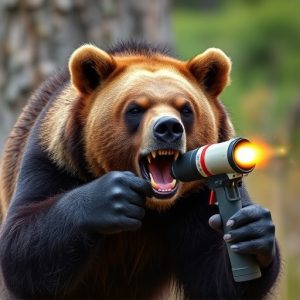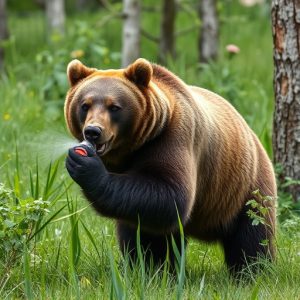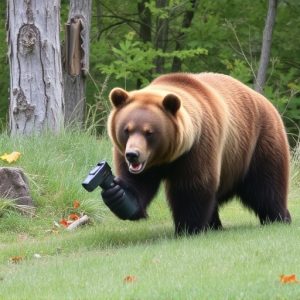Bear Spray Fog Pattern Test: Wilderness Defense Against Grizzly Bears
Understanding grizzly bear behavior is key to safe wilderness exploration. Key safety measures inclu…….
Understanding grizzly bear behavior is key to safe wilderness exploration. Key safety measures include recognizing patterns, using loud noises, and carrying bear spray, which creates a sensory barrier through capsicum-based chemicals when activated. The Bear Spray Fog Pattern Test ensures effective coverage (up to 30 ft) by measuring mist dispersion, emphasizing the importance of proper training and behavior understanding alongside bear spray use. Selecting the right spray with rigorous testing results and considering factors like can size, weight, and ease of use is crucial for potential encounters. Additionally, strategies like making noise, traveling in groups, and awareness of surroundings enhance safety.
In the vast wilderness, encountering a grizzly bear can be a terrifying prospect. Understanding their behavior and preparing with effective defense tools are crucial for safety. This article explores various aspects of protecting yourself against charging bears, focusing on the science behind bear spray. We delve into the results of bear spray fog pattern tests, offering insights on performance in different conditions. Additionally, practical tips go beyond spray, ensuring comprehensive wilderness defense strategies.
- Understanding Grizzly Bear Behavior: Key Factors to Stay Safe
- The Science Behind Bear Spray: How It Works and Effective Range
- Bear Spray Fog Pattern Test Results: Analyzing Performance in Different Conditions
- Choosing the Right Bear Spray: Considerations for Purchase and Usage
- Practical Tips for Wilderness Defense: Beyond Bear Spray, Ensuring Your Safety
Understanding Grizzly Bear Behavior: Key Factors to Stay Safe
Understanding Grizzly Bear Behavior is key when venturing into their wilderness. These powerful animals are generally shy and will avoid humans, but they can become aggressive if they feel threatened or surprised. Key factors to consider include recognizing their behavior patterns and understanding what might trigger them. Grizzly bears have an excellent sense of smell and hearing, so making loud noises before entering their habitat can help deter them.
A Bear Spray Fog Pattern Test is a recommended safety measure. Using bear spray effectively requires understanding its range and how to apply it correctly. The fog pattern should cover the bear from head to tail, creating a barrier that disrupts their sense of smell and vision. Staying calm, backing away slowly while spraying, and avoiding direct eye contact can significantly reduce the risk of an attack.
The Science Behind Bear Spray: How It Works and Effective Range
Bear spray, also known as bear repellent, is a popular defense mechanism used by hikers, campers, and outdoor enthusiasts when venturing into grizzly bear country. The science behind bear spray revolves around its ability to create a barrier between the user and the bear through a unique fog pattern. When activated, bear spray releases a fine mist of capsicum-based chemicals into the air, which are known to cause irritation in a bear’s eyes and nasal passages. This immediate sensory overload disrupts the bear’s behavior, giving the human an opportunity to retreat or escape.
The effectiveness of bear spray is often measured by the Bear Spray Fog Pattern Test, which evaluates how well the spray disperses and covers an area. A successful bear spray should create a dense fog that can reach up to 30 feet (9 meters) in ideal conditions, providing a safety zone for the user. This range ensures that even if a bear charges, it will encounter the irritant particles, temporarily deterring it from pursuing. It’s important to note that bear spray is not a guarantee of safety; proper training and an awareness of bear behavior are equally vital when navigating grizzly country.
Bear Spray Fog Pattern Test Results: Analyzing Performance in Different Conditions
Bear Spray Fog Pattern Tests have been instrumental in evaluating the effectiveness of self-defense aerosols against aggressive grizzly bears. These tests simulate real-world scenarios, releasing bear spray into controlled environments and measuring its fog pattern and impact. The results provide valuable insights into the optimal range, visibility, and duration of protection offered by these defensive tools.
In varying weather conditions, from calm days to windy forests, researchers have found that the fog pattern can significantly affect the spray’s performance. Bear Spray Fog Pattern Tests reveal that a fine mist, rather than a dense cloud, is more effective in reducing bear aggression over longer distances. This knowledge helps hikers and wilderness enthusiasts choose bear sprays designed for optimal fog dispersion, ensuring their safety during encounters with these powerful animals.
Choosing the Right Bear Spray: Considerations for Purchase and Usage
When considering bear spray as a defense against charging grizzly bears, it’s crucial to choose the right product for your needs. One key factor is understanding the bear spray fog pattern test results. This refers to how far and effectively the spray can reach and cover an attacking bear. Look for brands that conduct rigorous testing to ensure their sprays can be deployed from a safe distance, usually 20-30 feet (6-9 meters), allowing you time to retreat or negotiate with the bear.
During purchase, consider factors like can size, weight, and ease of use. Larger cans offer more protection but might be bulkier. Smaller, lighter options are easier to carry but may have shorter ranges. Check reviews for real-world feedback on effectiveness and reliability. Additionally, familiarize yourself with local regulations regarding bear spray possession and usage, as these vary by region.
Practical Tips for Wilderness Defense: Beyond Bear Spray, Ensuring Your Safety
When it comes to protecting yourself in the wilderness against charging grizzly bears, bear spray has long been the go-to defense. However, beyond relying on this common tool, there are practical tips for enhancing your safety measures. One crucial aspect is understanding the effectiveness of different spray patterns. The Bear Spray Fog Pattern Test reveals that certain techniques can significantly improve coverage and reduce the risk of close encounters. By aiming for a wider, more diffuse spray pattern, you increase the likelihood of creating a barrier between you and the bear, as opposed to directly hitting it in the face.
In addition to mastering spray techniques, other defensive strategies include making noise to deter bears, traveling in groups, and carrying essential survival gear like a sturdy knife or pepper spray specifically designed for wildlife encounters. Being mindful of your surroundings, recognizing bear signs, and knowing how to respond appropriately are also vital skills for navigating potential bear encounters safely.
When venturing into bear country, equipping yourself with knowledge of grizzly behavior and reliable defense tools like bear spray is paramount. The science behind bear spray, as evidenced by recent Bear Spray Fog Pattern Test results, highlights its effectiveness within a specific range. Proper usage, combined with practical safety tips, ensures a safer experience in the wilderness. Always choose a high-quality product tailored to your needs and stay vigilant, as prevention is key when facing these formidable creatures.


